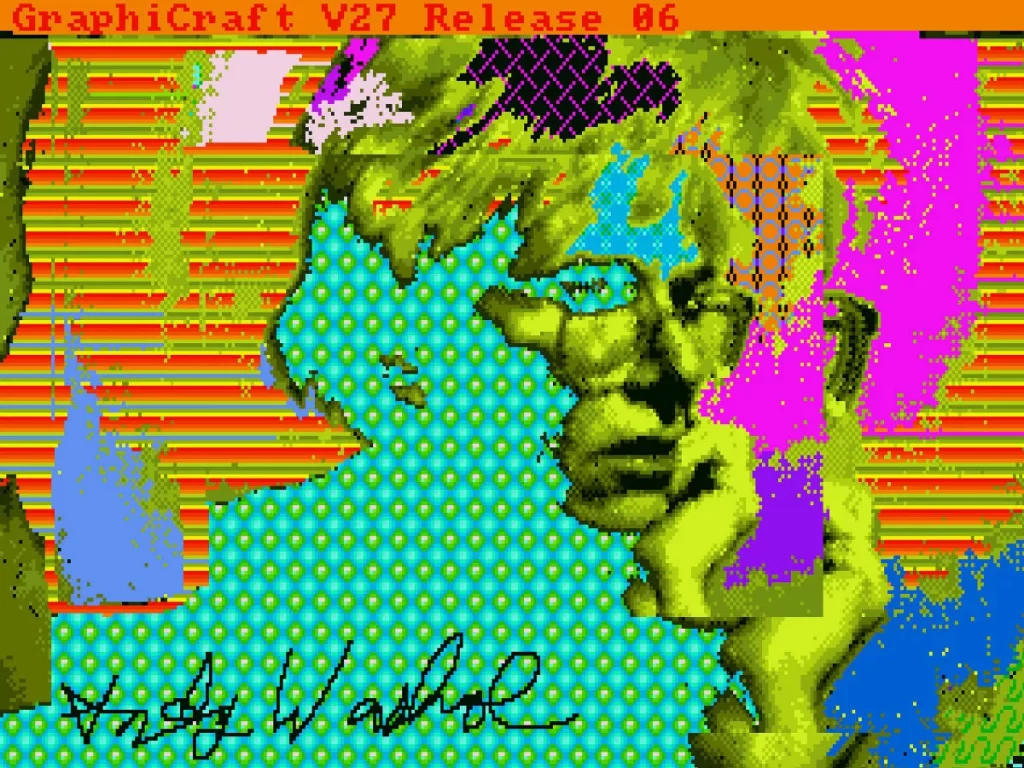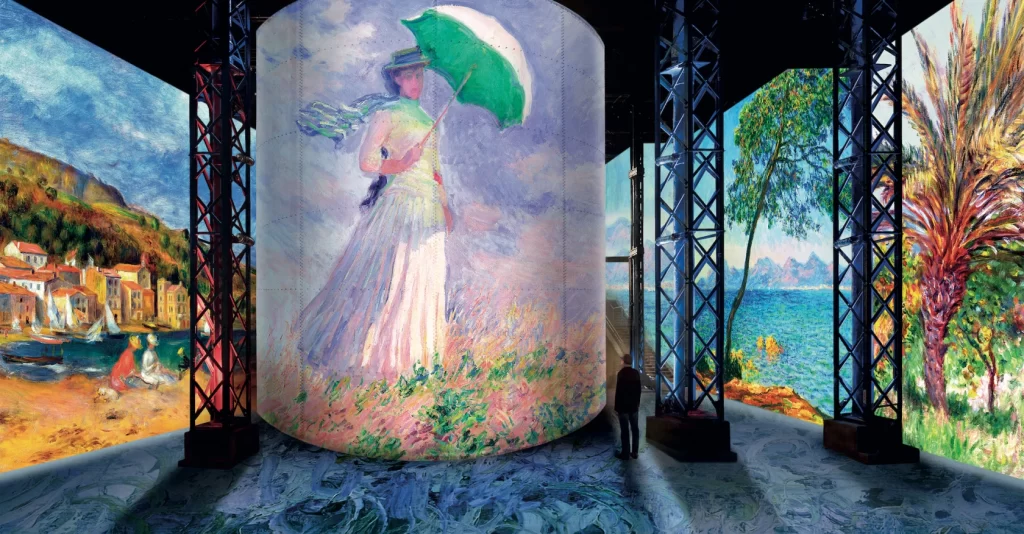How Digital Art Challenges Traditional Art
written by art historian & curator
Go back in time and enter any of the famous Palaeolithic caves full of animal representations, finger prints, and hunting scenes. We are amazed by how prehistoric pigments and drawings survived until today so that we can witness their greatness.
Imagine you are standing in front of a painting. You are admiring Vermeer’s famous Girl with a Pearl Earring. Great portrait, with wonderful contrast, light, and colours. That vivid look makes you shiver. The perfection of the painting technique astonishes you second by second. You dive into an unknown universe thinking about the girl, about the artist, and the meaning of the work.
Join our free online talks:
Now imagine you move to an obscure room and admire a digital creation that is running on a large screen. There is movement, maybe a character blinks or the rivers flow. It looks so real that you feel immersed in the story. However, you can not smell it, or see the layers behind it because this is digital content.
Nowadays there are various artistic mediums so how can one tell which is more relevant? Will the birth of a new technique bring the death of older ones? Will digital tools replace classic art? If this happens does it mean traditional mediums are obsolete?
Repeating History
Cave paintings are the first important step in humankind’s artistic development because with their birth people realised they can express themselves through art. This is no small thing as from this point onward expressions of visual arts such as painting, ceramics, sculpture, and architecture only progressed. We admire likewise ancient Egyptian art, classic Greek art, and Renaissance art although these are being separated by millennia. To state which one is more relevant is a matter of taste. Historically and visually speaking, all of them are impressive, expressive, symbolic, and speak a great deal about their times.

When photography was born the classic painting was challenged. For hundreds of years, painting was the principal vehicle to immortalise people, landscapes, and time. Aristocrats commissioned portraits that trespassed generations. Kings asked for large-painted sagas to speak about their conquests. At the beginning of the 19th century, photography started to take over painting’s job. In terms of realism, photography was doing it even better. Facing this turbulence, painting did not die but had to reinvent itself. From depicting figurative scenes, painting created possible worlds, dreamy scenery, and surrealist passages.
Painters choose to create differently, using new materials and by letting themselves be inspired by new themes. As a fact, technology helped a lot in ‘saving’ painting from death because modern art meant using new types of colours, oils, topics, new approaches, and a large palette of subjects, including a world in change and the beginning of technologisation. Most scholars believe that today’s digital art is playing a similar role – to capture society in a changing world.
What is Digital Art?
Digital artwork means any creative work that includes in its making process digital technology. Many names were used to describe this new medium of expression: computer art, new media art, internet art, or multimedia. Photography manipulation, digital collage, art generated by computers, digital paintings, and video are some of the oldest forms of digital art. John Whitney, a pioneer in digital art, used mathematical operations to create art. Famous Andy Warhol created digitally some of his best-known artworks. Back then, Warhol used graphic programs such as Amiga and ProPaint.
Digital paintings are obtained by programming algorithms or by vector graphics software. The information is being translated by a computer into 2D or 3D perspectives, with photorealistic imagery displayed on an electronic display. 3D computer graphics are a technology that stimulates interdisciplinary skills. Shapes and imagery with three dimensions are very popular in media segments such as film and television, video games and special visual effects, in theatre for the background decorations, entertainment such as concerts and festivals, and of course, art. Various software programs provide the tools for obtaining effects such as figures and virtual sceneries.

Digital brushes imitate the real paintbrush as well as acrylic, charcoal, pastel, and airbrush. Artists can obtain art as good as hand-painted art. More than this, many creative individuals consider that computer-generated art has broadened the horizons of the creative sphere by giving birth to new means of expression and skills suitable to both professional and amateur artists. Digital animations provide the tools to create not only visual forms but also a realistic environment in which they can move, live and exist. New art is using digital tools for a modern form of visual media, engaging and immersive, offering a distinct dimension to art, a distinct dimension to reality and contemporaneity. It can be an alternative way of life where real people create avatars and imagine for themselves a new body, friends, family, and social status.
Cultural and Creative Sectors & Digital Art
Other cultural and creative sectors took great advantage of digitalization by improving the quality of their work and opening their gates to everyone. Education is one fundamental sector that bases its modern learning process on digital visual tools. Many videos, animations, and software for mathematics and physics help students to better understand the information. Art history and archeology courses today are unthinkable without digital presentations.

Cultural festivals and art exhibitions offer participants the opportunity to admire and to interact with art. To say that traditional art is obsolete would be a mistake. Just as education is changing and improving its teaching methods, art is adapting to its creators and users. Together with digital art, we enter an era where contemporary means creating with new tools, approaching new subjects, and being integrated in a participatory way into the evolution of art and society. Just as modern artists looked at previous generations of artists, future generations will learn too from traditional art. Traditional art is being integrated and referred to in new works of digital origins, with new looks, meanings, and resonance to the public.
One of the best things digital art has achieved compared to classic museums was to bring new audiences to museums and contemporary cultural centres. Young people are now looking toward digital exhibitions as contemporary manifestations that understand their generation, and their concerns and provide an alternative way to learn and have fun.
Recognition
In 2005 the first museum dedicated to digital art opened in Switzerland, Zurich. Many other museums added digital art sections to their exhibitions. The infusion of art and digital tools is shaping new types of culture, just as humankind is being shaped every day by digitalization. The artwork ”Edmond de Bellamy” created by the collective Obvious was sold in 2018 at Christie’s auction house in New York for US$432,500. Both professional and amateur artists received recognition for their skills. For instance, in 2022 Refik Anadol created an installation using digital tools for the Museum of Modern Art in New York while a non-professional artist won the first-place prize at a digital art competition organised by Colorado State Fair. This shows just how accessible new art is and how it connects with multiple societal segments.
Compared to the past, art and digital art in particular do not seem out of our sphere anymore. We can all recognise elements from our daily lives, work, or family. The issues in the new art are familiar to us, we are all being touched by it and it’s easier to resonate with it.

With the help of new digital tools, artists reduce the time necessary to create layers over layers. Sometimes, they use generators to create an image that the artist will improve in the end. So instead of creating a painting from scratch, artists have a base and work on top of that. Of course, this is a challenge to the traditional definition of making art but we must consider art has never been the same forever. Art has changed too from cave painting to classic art to land art and, finally to contemporary art. Digital art is just another form of artistic creativity, a form that exists together with classic painting, sculpture, environmental art, and so on. It is obvious that each technique has its own development process but one does not exclude the other and together participates to enrich our world with diverse and challenging forms of art.
Digital installation art, performances, augmented reality, and everything that is being created on the internet or with the help of digital tools develop a world of interactive experiences where people enter, breathe, touch, and sense art. Digital art is exhibited worldwide in museums and art galleries. Auction houses sell digital artworks and NFTs in both virtual galleries and real life. Today, digital art is a multidisciplinary field available for the creation of original art and research while traditional art will be the indestructible link of the past with future culture.
GET MORE FROM LEVEL


Leave a Reply